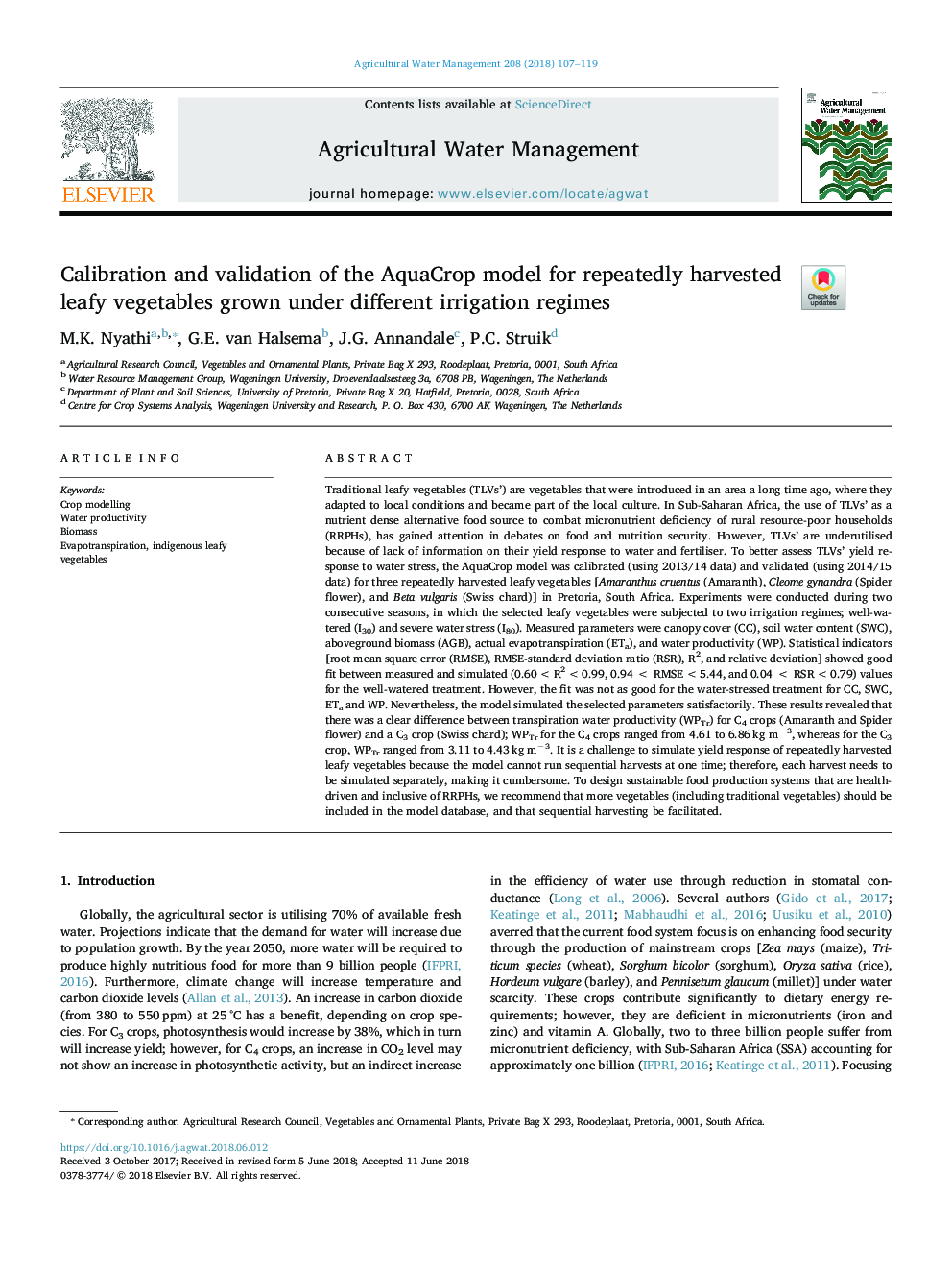| کد مقاله | کد نشریه | سال انتشار | مقاله انگلیسی | نسخه تمام متن |
|---|---|---|---|---|
| 8872757 | 1622872 | 2018 | 13 صفحه PDF | دانلود رایگان |
عنوان انگلیسی مقاله ISI
Calibration and validation of the AquaCrop model for repeatedly harvested leafy vegetables grown under different irrigation regimes
دانلود مقاله + سفارش ترجمه
دانلود مقاله ISI انگلیسی
رایگان برای ایرانیان
کلمات کلیدی
موضوعات مرتبط
علوم زیستی و بیوفناوری
علوم کشاورزی و بیولوژیک
علوم زراعت و اصلاح نباتات
پیش نمایش صفحه اول مقاله

چکیده انگلیسی
Traditional leafy vegetables (TLVs') are vegetables that were introduced in an area a long time ago, where they adapted to local conditions and became part of the local culture. In Sub-Saharan Africa, the use of TLVs' as a nutrient dense alternative food source to combat micronutrient deficiency of rural resource-poor households (RRPHs), has gained attention in debates on food and nutrition security. However, TLVs' are underutilised because of lack of information on their yield response to water and fertiliser. To better assess TLVs' yield response to water stress, the AquaCrop model was calibrated (using 2013/14 data) and validated (using 2014/15 data) for three repeatedly harvested leafy vegetables [Amaranthus cruentus (Amaranth), Cleome gynandra (Spider flower), and Beta vulgaris (Swiss chard)] in Pretoria, South Africa. Experiments were conducted during two consecutive seasons, in which the selected leafy vegetables were subjected to two irrigation regimes; well-watered (I30) and severe water stress (I80). Measured parameters were canopy cover (CC), soil water content (SWC), aboveground biomass (AGB), actual evapotranspiration (ETa), and water productivity (WP). Statistical indicators [root mean square error (RMSE), RMSE-standard deviation ratio (RSR), R2, and relative deviation] showed good fit between measured and simulated (0.60 < R2 < 0.99, 0.94â¯<â¯RMSE < 5.44, and 0.04â¯<â¯RSR < 0.79) values for the well-watered treatment. However, the fit was not as good for the water-stressed treatment for CC, SWC, ETa and WP. Nevertheless, the model simulated the selected parameters satisfactorily. These results revealed that there was a clear difference between transpiration water productivity (WPTr) for C4 crops (Amaranth and Spider flower) and a C3 crop (Swiss chard); WPTr for the C4 crops ranged from 4.61 to 6.86â¯kg mâ3, whereas for the C3 crop, WPTr ranged from 3.11 to 4.43â¯kg mâ3. It is a challenge to simulate yield response of repeatedly harvested leafy vegetables because the model cannot run sequential harvests at one time; therefore, each harvest needs to be simulated separately, making it cumbersome. To design sustainable food production systems that are health-driven and inclusive of RRPHs, we recommend that more vegetables (including traditional vegetables) should be included in the model database, and that sequential harvesting be facilitated.
ناشر
Database: Elsevier - ScienceDirect (ساینس دایرکت)
Journal: Agricultural Water Management - Volume 208, 30 September 2018, Pages 107-119
Journal: Agricultural Water Management - Volume 208, 30 September 2018, Pages 107-119
نویسندگان
M.K. Nyathi, G.E. van Halsema, J.G. Annandale, P.C. Struik,